The ocean is full of beautiful and wondrous creatures, hence our love for diving. Along with their majesty and wonder, however, some of these creatures can also possess the ability to inflict harm on us as we explore their underwater home. Most marine life injuries occur from one of two reasons. One, we are too aggressive toward the animal, they become threatened and feel the need to defend themselves. Two, we are not paying close enough attention to our surroundings, and we accidently step on, brush against, or touch a hazardous animal. All-in-all, the important thing to understand is that it is very rare to be unsuspectingly attacked by an unprovoked marine animal and that we are the ones normally at fault for incurring a marine life injury. The good news is that most marine life injuries are avoidable.
If, however, you are unfortunate enough to have a marine life injury happen to you, there are a few simple steps you can take to be prepared to deal with such an event. A rapid and appropriate response can greatly improve the outcome for the injured diver and quicken recovery time. Listed below are the main types of injuries, how they occur, signs and symptoms of each, and their appropriate first aid.
Marine Life Injuries can occur in basically 5 catigories: Spiny Envenomations, Stings, Contact Injuries, Traumatic Injuries, and Seafood Poisoning.
Spiny Envenomations
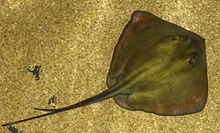 Can occur from contact with lionfish, stonefish, stingrays, sea urchins, etc. Signs and symptoms include puncture to the skin, sharp/stinging intense pain, protruding spines, swelling, blisters, skin discoloration, and nausea.
Can occur from contact with lionfish, stonefish, stingrays, sea urchins, etc. Signs and symptoms include puncture to the skin, sharp/stinging intense pain, protruding spines, swelling, blisters, skin discoloration, and nausea.
Envenomation First Aid
- Thoroughly wash area.
- Remove any spines with tweezers (except stingray spines; leave in to be removed at medical facility).
- Control any bleeding.
- Immerse injury in the hottest fresh water the victim can stand as soon as possible. (**it is important to note with spiny envenomations the victim will get no relief and pain will continue to intensify until the injury is immersed in very hot water**)
- Seek medical evaluation at nearest facility.
Stings
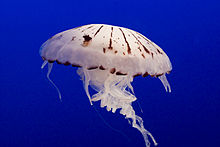 Can occur from contact with jellyfish, fire coral, anemones, and hydroids. Signs and symptoms include pain (some can be extreme), muscle cramps, welts, burning and itching, redness and swelling, blisters, nausea and fatigue. Some stings can have rapidly progressing symptoms.
Can occur from contact with jellyfish, fire coral, anemones, and hydroids. Signs and symptoms include pain (some can be extreme), muscle cramps, welts, burning and itching, redness and swelling, blisters, nausea and fatigue. Some stings can have rapidly progressing symptoms.
Stinging First Aid
- Inactivate stinging nematocysts by rinsing wounds with generous amounts of plain white vinegar. DO NOT rinse with fresh water OR rub off animal remnants as this will cause the nematocysts (the stinging parts) to keep firing.
- Remove larger remaining pieces with tweezers (wear gloves!).
- Treat symptoms: pain relief with medications, anti-inflammatory creams, etc.
- Monitor for allergic reaction or infections.
- Seek medical evaluation for severe stings.
Contact Injuries
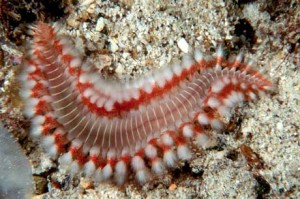 Can occur from contact with some sponges, corals and bristle worms. Signs and symptoms include sharp, stinging pain, localized redness, itching, swelling, burning and numbness sensations, blisters and bleeding associated with cuts or scrapes.
Can occur from contact with some sponges, corals and bristle worms. Signs and symptoms include sharp, stinging pain, localized redness, itching, swelling, burning and numbness sensations, blisters and bleeding associated with cuts or scrapes.
Contact Injury First Aid
- Wash area with soap and water.
- Remove foreign material (tape may help with removing bristles).
- Control any bleeding.
- Monitor for infection.
Traumatic Injuries
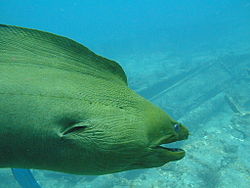 A traumatic injury can occur in the unlikely event that you are bitten by larger marine life such as a moray eel or shark. Signs and symptoms or a traumatic injury include severe bleeding and shock.
A traumatic injury can occur in the unlikely event that you are bitten by larger marine life such as a moray eel or shark. Signs and symptoms or a traumatic injury include severe bleeding and shock.
Traumatic Injury First Aid
- Wash with soapy water.
- Control bleeding with direct pressure.
- Apply dressing to injury (never remove soaked dressings, just continue applying new dressings on top of old ones) and wrap dressing with bandage once bleeding has stopped.
- Seek medical evaluation.
- Monitor for infection.
Seafood Poisoning
Can occur from eating raw, undercooked or improperly stored fish and shellfish. Eating thoroughly cooked fish and shellfish containing ciguatera or during a red tide will still cause seafood poisoning. Signs and symptoms include abdominal pain, nausea, vomiting, diarrhea, numbness, itching and tingling, lack of muscle coordination, and sometimes paralysis.
Seafood Poisoning First Aid
- Monitor responsiveness.
- Contact local poison control center.
- Save eaten fish or vomitus for evaluation if possible.
- Seek medical evaluation.
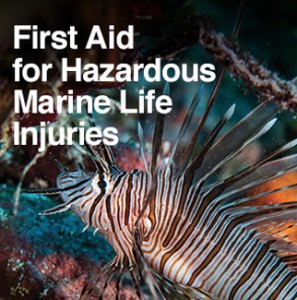 Education is the key to preventing and treating possible marine life injuries. Now that you know the basics, it is easy to understand how to prevent them from happening to you, but if you or your buddy are unfortunate enough to come into contact with one of these animals you will know how to be prepared to quickly respond in the appropriate way. To further your education in these matters check out the Hazardous Marine Life Injuries course offered by DAN (Divers Alert Network). Also, now that you know how to deal with these types of issues that are normally found in tropical diving, check out our up-coming dive trip to beautiful Cozumel!
Education is the key to preventing and treating possible marine life injuries. Now that you know the basics, it is easy to understand how to prevent them from happening to you, but if you or your buddy are unfortunate enough to come into contact with one of these animals you will know how to be prepared to quickly respond in the appropriate way. To further your education in these matters check out the Hazardous Marine Life Injuries course offered by DAN (Divers Alert Network). Also, now that you know how to deal with these types of issues that are normally found in tropical diving, check out our up-coming dive trip to beautiful Cozumel!



